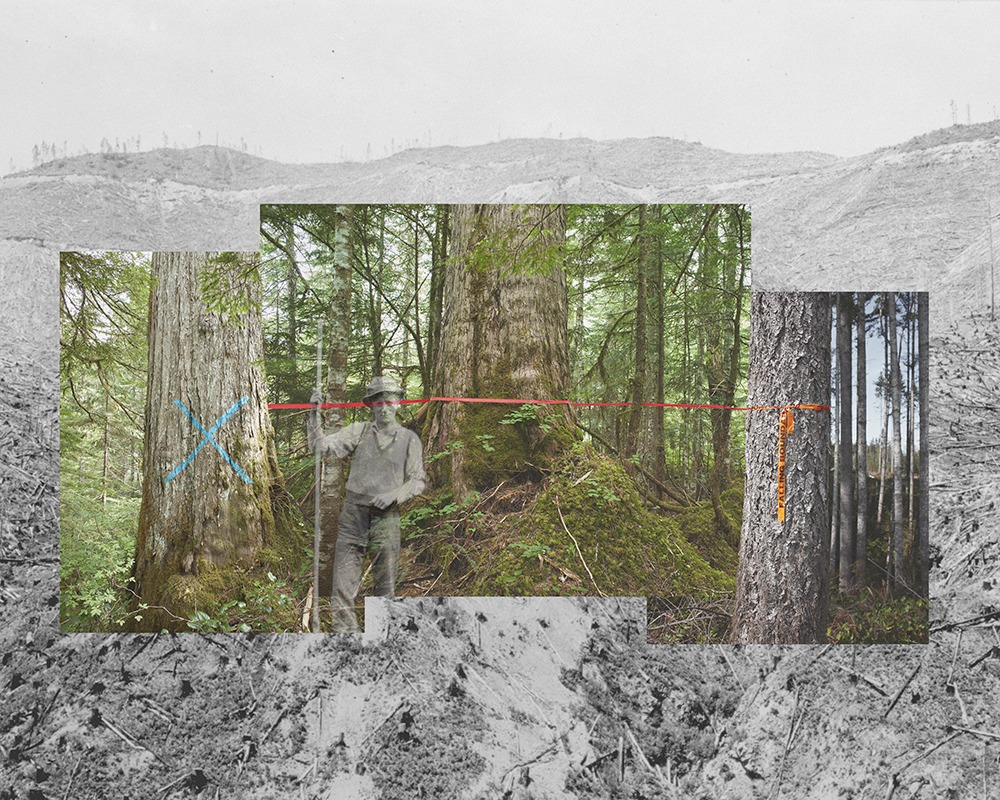
Falling Boundary
Pigment ink on cotton rag, 30×37.5 inches, Edition of 5
With an immigrant family history intimately connected with the forest as a backdrop, Falling Boundaries explores deforestation in British Columbia over the last century as it weaves together threads of resource extraction and the reverberating effects of colonialism within the deepening environmental crisis.
My family were among the early European immigrants to the Pacific Northwest and the first to settle on remote Cortes Island in 1887. In contrast to the worldview of the indigenous nations – at least those left after initial colonization – settlers brought with them their cultural perspectives on the seemingly inexhaustible forest, now viewed as a “resource” within an extractive market economy. As industry mechanization progressed from the end of the 19th century to present day the easily accessible tracts of forest were removed first. When those trees were gone, and the value of timber increased, harvesting slowly progressed up the mountainsides and into inhospitable areas once considered to be inefficient from a cost perspective. This wood is now so valuable that those concerns have evaporated.
The ancient forest of British Columbia now finds itself effectively nearing an end – of the original forest currently only 2.7% remains of its “big tree” old growth.
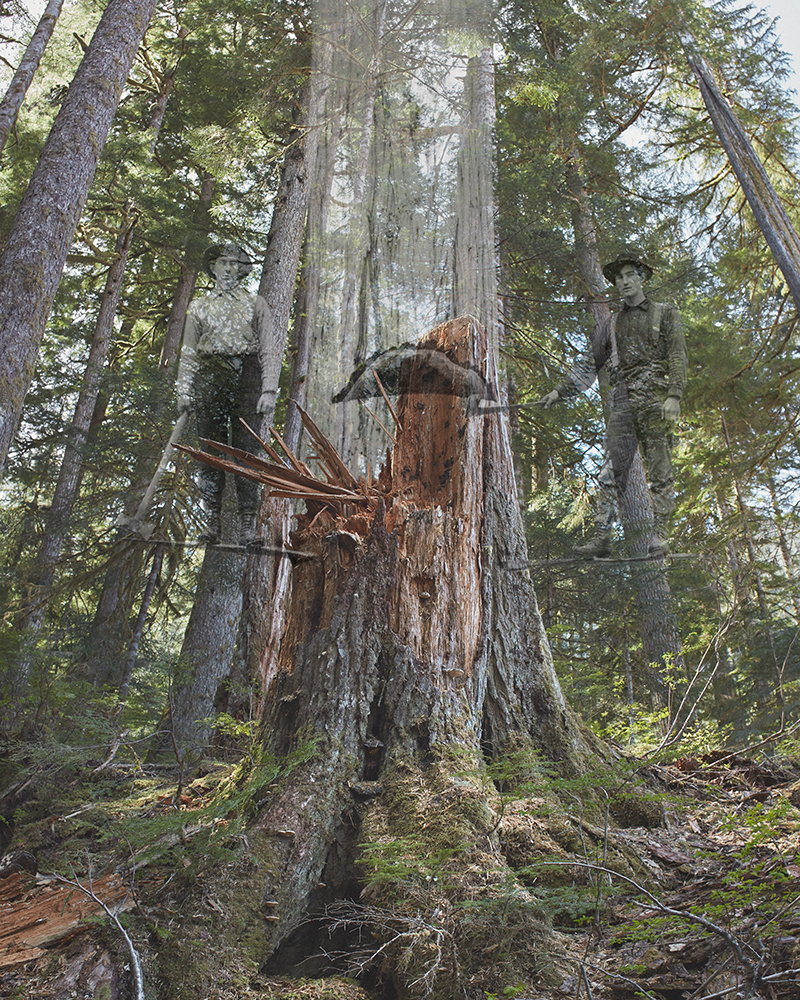
Undercut
Pigment ink on cotton rag, 37.5×30 inches, edition of 5
In Conversation with Gina Thomas
In an effort to widen the scope of this project it includes an interview with Gina Thomas of the Tlowitsis First Nation in British Columbia. Gina contributes an indigenous perspective to the impacts of colonial resource extraction. Thomas has worked in partnership with her band off and on for nearly twenty years doing archaeological impact assessments, and now the past six years as a Tlowitsis Guardian Watchman. She previously spent four years with Western Forest Products conducting silviculture surveys, independently worked on various research projects, and on engineering work for Strategic Environmental Services.
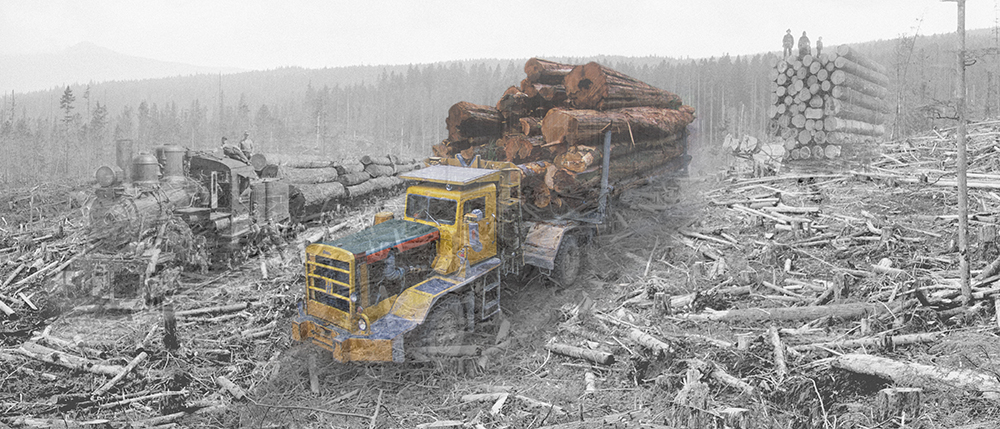
A Clearing
Pigment ink on cotton rag, 20×35 inches, edition of 5
(Excerpt follows. For complete interview click here)
David Ellingsen (DE): Much has been written about the decline of the great forests, both here in British Columbia and around the world. Do you have any comment on the impacts on Indigenous culture?
Gina Thomas (GT): Simply, our way of life has been taken from us. Nature was our home, grocery store, pharmacy, and inspiration for art and ceremony. Our people have and always will be tied to these lands. When First Nations people were gathered and forced onto reserves, it broke the connection we have to the land, and also much of our spirit. Initially the argument was that this was for our own good, but evidently all these efforts did severely harm us. I have the unique perspective of seeing the brokenness of both our people and the land. It is well past time to heal both, so that one day they might prosper again.
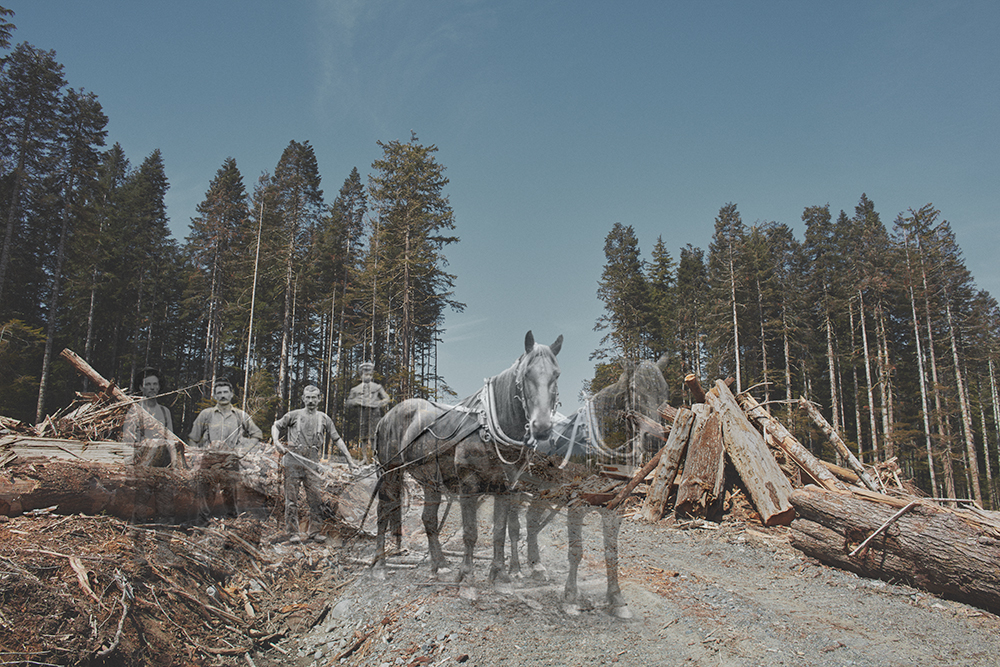
Selective Memory
Pigment ink on cotton rag, 30×45 inches, edition of 5
DE: I come from a settler background with four generations, to date, working in the BC forest industry. I am keenly aware of the values our culture brought with us around resource extraction, capitalism and racism, values which arguably have brought us to this environmental precipice. Do you have any thoughts on reconciliation and its relationship to a shift in the way settler culture views the natural world?
GT:
I think that reconciliation and its relationship on how we treat the natural world still has many challenges. One of the largest will be working with government agencies which still manage our resources in a disconnected, colonial manner. The natural world cannot be managed within neat little boxes with statistical analysis being the primary decision maker. The problem with managing resources today is that we never have enough information; nature is completely interconnected and to understand any singular component we must first look at the bigger picture with a holistic approach. Those who manage resources should be people who are directly impacted by their removal, otherwise it seems too easy to forget the consequences of our actions.
As settlers were immigrating to British Columbia, they took most of the land occupied by First Nations communities and viewed the ‘newly’ discovered resources as being ‘wasted’ if not being extracted for use. In Europe, we know that the industrial revolution devastated the natural ecosystems and polluted the air and water ways. Joseph Trutch was a major player in crowding First Nations peoples onto small pieces of land (reserves) – and this land was not often ideal. It was typically land the immigrants did not want either.
At the same time First Nations populations were decimated by diseases such as smallpox and tuberculosis, and the genocide resulting from the residential school system. The goal of residential schools was to assimilate our people into European culture, although never to be on equal footing with them. The attempts to disconnect First Nations from our languages, ceremonial practices and traditional lands were severe and caused irreparable damage. However, they did not succeed with assimilation, and now we are in a time of limbo where many communities do not know how to exist in this colonial world, and it’s not possible for
them to go back to their traditional way of life. The repercussions and aftershocks are still highly visible in First Nations communities with substance abuse and addiction, severe mental health issues, and poverty. The horrible impacts on communities after having children ripped away from their families, completely removed from their cultures and everything they knew, are still being felt and can only mend with time.
First Nations communities, with the odd exception, had not expected this, and had originally believed that the settlers were looking to share the plentiful lands and resources. The surviving communities have spent the past century watching the natural world in which they thrived be systematically exploited. An understanding of what actually transpired, on both sides, is what is needed to truly begin reconciling. Colonial perspectives will never understand First Nations communities wants and needs.
All this talk about reconciliation must be followed by real action to protect the natural world, if it is meant sincerely. The ‘precipice’ is a perfect term for where we are at; we can come together and work towards a healthier future, or we can simply let things go and spiral into disaster.
For the complete interview click here.
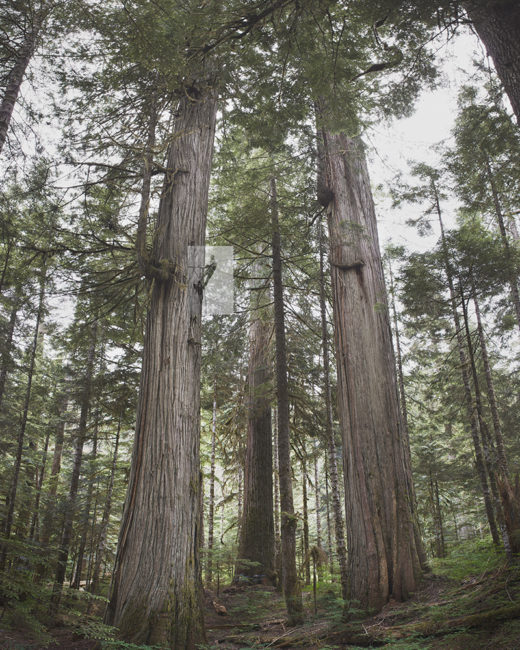
High Rigging
Pigment ink on cotton rag, 37.5×30 inches, edition of 5
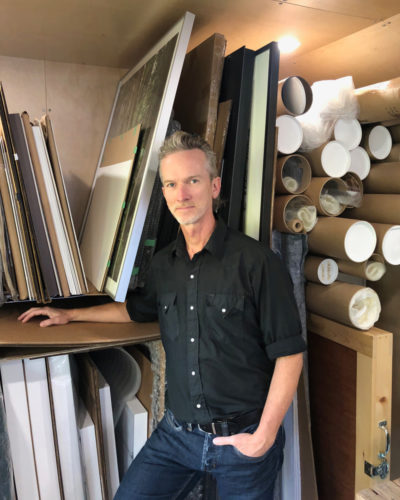 David Ellingsen is a Canadian photographer creating images that speak to the relationship between humans and the natural world. He works predominantly on long-term projects with a focus on climate, biodiversity, and the forest. Recent exhibitions include China’s Lishui Museum of Art, the San Jose Institute of Contemporary Art, Lithuania’s Kaunas Photo Festival, and Canada’s Campbell River Museum. Ellingsen’s photographs are part of the permanent collections of South Korea’s Datz Museum of Art, China’s Photography Museum of Lishui, Canada’s Beaty Biodiversity Museum, and the Royal British Columbia Museum. With his husband, Ellingsen lives and works in the Pacific Northwest with a place-based practice formed by the landscape where he was raised.
David Ellingsen is a Canadian photographer creating images that speak to the relationship between humans and the natural world. He works predominantly on long-term projects with a focus on climate, biodiversity, and the forest. Recent exhibitions include China’s Lishui Museum of Art, the San Jose Institute of Contemporary Art, Lithuania’s Kaunas Photo Festival, and Canada’s Campbell River Museum. Ellingsen’s photographs are part of the permanent collections of South Korea’s Datz Museum of Art, China’s Photography Museum of Lishui, Canada’s Beaty Biodiversity Museum, and the Royal British Columbia Museum. With his husband, Ellingsen lives and works in the Pacific Northwest with a place-based practice formed by the landscape where he was raised.This article is part of the MAHB Arts Community‘s “More About the Arts and the Anthropocene”. If you are an artist interested in sharing your thoughts and artwork, as it relates to the topic, please send a message to Michele Guieu, Eco-Artist and MAHB Arts Community coordinator: michele@mahbonline.org. Thank you. ~

